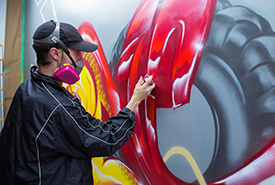Summer demolition
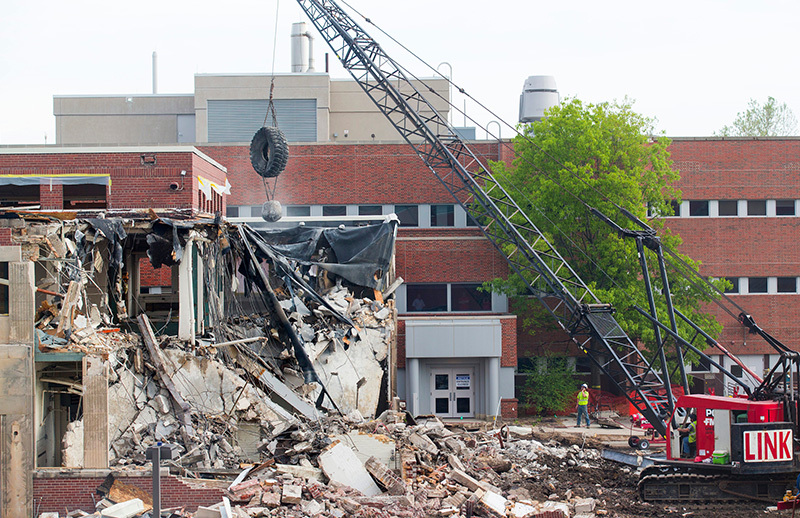
Following several months of building prep and asbestos abatement, the time finally arrived this week to demolish Nuclear Engineering Laboratory and the oldest (southeast) section of Sweeney Hall to make room for the future Student Innovation Center. Visible to the north in the background is Sweeney Hall. Crews also removed the fountain and concrete wall north of Hoover Hall. Photos by Christopher Gannon.
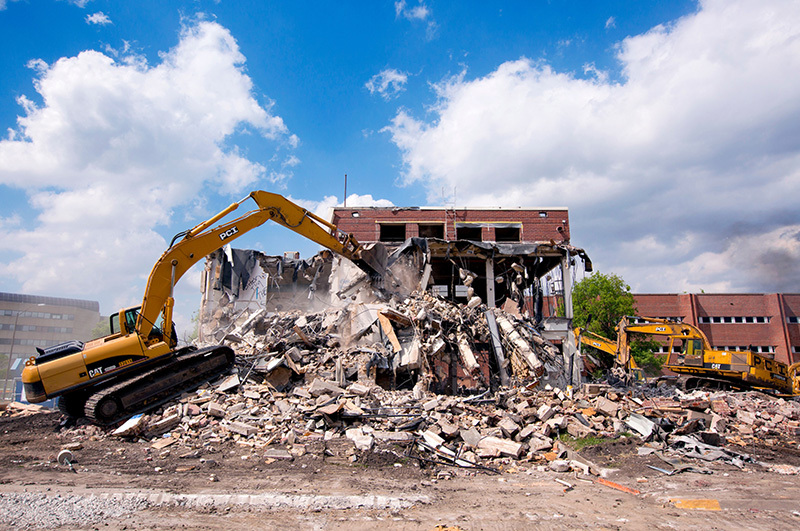
University to collect job information from P&S employees
In the month of June, all Professional and Scientific employees can expect an email from university human resources providing details about a job collection process and the tool they'll use to document their job information. Instructions will be provided on how to fill out the Job Profile Tool (JPT), route the completed tool and a timeline for completion. This is one of the early pieces of an 18-month review of the university's classification and compensation structure for P&S employees.
Compensation and classification director Emma Mallarino Houghton said the job profile tool is an opportunity for P&S employees to share information about their positions that will help inform and shape the future classification structure. Using the JPT, in their own words employees will summarize their positions, including their standard duties. Employees also will be asked to weigh in on what education, experience, licensures and certifications should be required or preferred for their positions. The JPT also gives supervisors the opportunity to validate the information employees provide and share feedback about the position(s) they directly supervise. Temporary P&S employees will not need to fill out the JPT.
"Ultimately, the job collection process is an opportunity for employees and supervisors to provide very valuable input into this process," Mallarino Houghton said. "The information gathered in this tool will inform the development of the new classification structure, help define job classifications and families, and identify gaps in today's structure."
Executive interviews also underway
Interviews with university leaders, led by Aon consultants, took place on May 15-16, with more scheduled for May 19 and 23. Mallarino Houghton said the purpose of the interviews is to gather input from leaders about the current state and desired future state of the classification structure and to develop a compensation philosophy, which will be critical to the project and how it takes shape.
The primary goal of the classification and compensation review is to address the need for a modern P&S classification and compensation structure. Specifically, a new structure should:
- Create and establish a university-wide compensation philosophy for P&S staff
- Develop defined job categories and job families for P&S jobs
- Develop a defined P&S pay structure that balances market, equity and performance
- Develop defined pay administration policies and practices to maintain a modern and competitive pay program
- Better define pathways for P&S career development
Questions regarding the Job Profile Tool or the classification/compensation review project may be emailed to uhrcc@iastate.edu.
Related story
May 4, 2017: University kicks off review of P&S classification/compensation structure
Center spared from elimination, but loses state funding
With its state funding eliminated, Leopold Center director Mark Rasmussen and College of Agriculture and Life Sciences endowed dean Wendy Wintersteen said options will be reviewed to discern the center's future with resources available from current or future philanthropy.
On May 12, Gov. Terry Branstad signed a bill that ended state funding to the Leopold Center for Sustainable Agriculture, but used his line item veto to remove language that would have eliminated the center. University leaders and many alumni and supporters advocated for the line-item veto to preserve the center's existence.
"We are grateful to the Governor for the opportunity to retain the Leopold Center name, which is meaningful to the university and to many alumni, partners and stakeholders impacted by education or research results made possible by the center over the past three decades," Wintersteen said.
In a statement, Rasmussen said, "For 30 years, the Leopold Center has offered hope, new knowledge and significant research findings to Iowa and the nation. While we appreciate the name and the center will remain, the loss of all state funding severely restricts operations and our ability to serve our many stakeholders."
State funds reduced to zero
The legislation cut approximately $1.9 million in state support from the center, including a nearly $400,000 direct appropriation. The same bill eliminated a $1.32 million appropriation to the Iowa Nutrient Research Center -- also at Iowa State -- and replaced it with an estimated $1.5 million formerly received by the Leopold Center from a state pool generated through nitrogen fertilizer sales and pesticide registrations. The action essentially leaves intact the Iowa Nutrient Research Center, which in the last four years has funded more than 40 research projects led by ISU, University of Iowa and University of Northern Iowa scientists.
The legislation tasked the college with managing the completion of Leopold Center competitive-grant projects funded by previously allocated state funds. Currently, 49 projects are active. Other projects are funded by private gifts to the center and support for those will continue.
The Leopold Center receives about $250,000 each year generated from an endowment.
Decisions on future staffing of the center will follow established university policy on budget-related workforce changes or reorganizations. The center currently supports two faculty and six staff. Rasmussen will continue to serve as center director.
Butterflies? There's an app for that
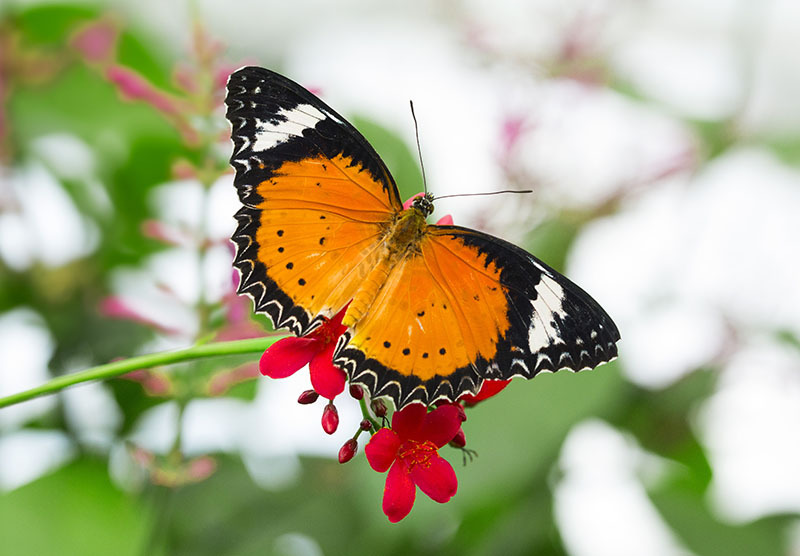
Photo by Christopher Gannon.
When Nathan Brockman needed a one-of-a-kind application developed for mobile devices, he knew exactly where to start.
Brockman, an entomologist at Reiman Gardens and curator of the Christina Reiman Butterfly Wing, submitted his proposal to students enrolled in a two-semester senior design course offered by the electrical and computer engineering department. He wanted a survey tool for researchers and individuals trained to monitor butterfly populations. It's something he put on a wish list during a meeting of the North American Butterfly Monitoring Network.
"I put in a proposal to the class and it was accepted," Brockman said. "We run a statewide program where we train citizen scientists to go out in the field and survey butterflies. Most of that work had been done on paper. I really wanted a mobile way to do it, to speed the process up."
The free Unified Butterfly Recorder (UBR) app allows users to record butterfly sightings that utilize the built-in capabilities of their mobile devices to include the time, GPS coordinates and local weather conditions. Participants submit their data -- generated by the app as an Excel spreadsheet -- for inclusion in a database.
Training
Interested in helping to survey butterfly populations? Apply to be a member of the Iowa Butterfly Survey Network. Training and certification is required.
Downloads
Instructions for using Flutr will be published on the Reiman Gardens website. The Unified Butterfly Recorder (UBR) app is available now as a free download on:
Student-powered development
The development process began in December 2013. Since then, five different teams (on average, about four students per team) developed and updated the app for both Android and Apple (iOS) devices, and created a web-based link for data collection and analysis. The first student team created the Android version.
"We focused on the Android app, because that's the device I know, and it's easier and cheaper than iOS development," Brockman said. "They came up with some amazing functionalities that were things that I didn't even think of."
The second group fell just short of producing an iOS version of the app, which was finished by the fourth group.
"Piece by piece, we've been building this app up, using different groups of students," Brockman said. "It makes for a long form of development, but it really allows us to test it out."
Once the app was built, the student teams focused on a "connection piece" that links the app to a custom database. The third and fifth student teams created that web-based interface and the Flutr (pronounced "flutter") database, which should be operational this summer.
"Our participants have been using the app, downloading and sending us data files, and we've been entering them into a third-party database for them," Brockman said. "But with Flutr, participants will be able to go on their devices, push a button and send their surveys right into that database."
Beyond butterflies
With more than 500 downloads, Brockman said the UBR app already has been used for a variety of population studies. Users include the Iowa Department of Natural Resources (summer butterfly project), Toledo and Minnesota zoos (butterfly and bumblebee surveys), and extension and outreach (youth insect tour).
"It's not built for just one certain protocol," Brockman said. "You can choose from an assortment of survey types. Different groups can use it for their own purposes."
The UBR app's customizable fields open it up to just about any population study -- from butterflies, to birds, to trees and more. Flutr also will be accessible to outside groups and users to coordinate and share their data.
"The app allows different researchers using different standards and protocols to easily pull their data together," Brockman said. "Flutr allows any group to compile their data into a pool."
Implementation planning begins for CyRide route changes
While changes won't be implemented for a year yet, CyRide is moving toward a revamped route structure and schedule. Last month, CyRide's six-member transit board approved a new 13-route proposal, and consultants on the project have worked since then to develop implementation documents. When the transit board next meets on May 24, CyRide director Sheri Kyras said members expect to review several key pieces developed by the traffic consultants, Nelson Nygaard, including:
- Schedules for all 13 routes and how they integrate with each other
- A phased implementation plan (specific routes would be added or modified over numerous months)
- Assessment of the new route structure/schedule on specific locations, such as Union Drive near Friley Hall, where bus and pedestrian congestion might be a concern
- Recommendations for additional service pieces, requested by clients in last winter's survey or focal groups, that could be added as funds become available
Kyras said that although the board has approved the new route structure, it still can be tweaked. One of the pre-implementation tasks for her staff will be to hold public hearings on the approved schedules, likely this fall. CyRide staff also will develop plans for implementing the changes to actual bus stops, bus stop signage and printed and online schedules.
She said implementation of the route changes likely will begin next May and be phased in through fall 2018.
"I'm really comfortable with the new route structure," Kyras said. "It formalizes some things we as a staff have talked about in the last few years; it also responds to many of the requests we heard from the public."
Route changes
The approved 13-route plan eliminates four routes, adds three and significantly modifies four (other routes were tweaked for frequency or timespan of service).
The new structure features:
- A new name (Cherry) for the current Red 1A route, providing additional west and southwest Ames service to campus via South Dakota Avenue and Lincoln Way, only on ISU class days
- A new route (Peach) between the Vet Med campus and North Grand Mall via central campus and Stange Road
- A new express service (Lilac), during morning and late afternoon peak hours only, from Dickenson Avenue in southwest Ames to the ISU campus via Mortensen Road and State Street
The approved proposal made notable changes to these routes:
- Orange: Frequency increases to four minutes; no longer services Vet Med campus
- Gold: The expanded route connects Schilletter Village, University Village, central campus and the Towers residence halls
- Blue: No longer provides service between North Grand Mall and campus and instead focuses on service between campus and the South Duff area via South Fourth Street, with greater frequency during peak times
- Yellow: Provides service all day between downtown and the Southdale neighborhood via South Duff Avenue (currently ceases for about four hours midday)
These current routes will be eliminated:
- Aqua: A summer-only route from downtown Ames to Furman Aquatic Center
- Pink: Limited weekday service along East Lincoln Way to Dayton Avenue and north to 13th Street
- Gray: Weekday service that connects central campus with southeastern Ames via University Boulevard, South 16th Street and Bell Avenue
- Silver: Sunday night shuttle service (when ISU classes meet on Monday) from stadium lots to three residence hall neighborhoods
Kyras said the eliminations are the result of low ridership data and information received from the public. CyRide will provide hourly service between City Hall and eastern Ames (east of the Skunk River to I-35), with riders calling CyRide for service back to City Hall. A summary of the route changes is on the CyRide website.
Since last July, the transit system has been conducting a study to determine the most efficient way to run the bus system. Kyras said in the last 10 years, annual ridership has jumped from 4 million to 7 million riders, with essentially the same route structure.
Expect parking lot and road closures next week
Special Olympics Iowa competition venues
- Bergstrom Football Complex (rain location only)
- Beyer Hall pool
- Forker Building
- Forker tennis courts
- Hilton Coliseum
- Iowa State Center parking lots
- Lied Center
- Lied fields
- MWL fields
More than 4,000 visitors will be on campus May 25-27, competing, watching or volunteering during the Special Olympics Iowa summer games. Select parking lots and roads will be closed to accommodate events and activities staged in several campus venues.
Volunteers
All volunteers must check in Thursday and Friday at the tent in parking lot S6, east of Jack Trice Stadium. Volunteers and visitors are asked to use the bus shuttles, which run from lot S6 to the competition venues on Thursday and Friday. Shuttles will not operate on Saturday and volunteer check-in moves to the Lied Center.
Road closures
- Beach Road: Closed to through traffic from Lincoln Way to the power plant, 7:30 a.m.-10 p.m. Thursday and Friday 


- South Fourth Street: Closed from Beach Avenue to just west of entrance to stadium parking lots, 8 a.m.-5 p.m. Thursday 


Parking lot closures
Portions of lot 100, east of the Lied Center, will close on Monday for event preparations. Other parking lot closures include:
- Beyer Hall: Lot 3, Friday (all day); open only to 24-hour Reserve or handicap permit holders
- Forker Building: Lot 50A, Thursday and Friday (all day); open only to 24-hour Reserve and handicap permit holders
- Iowa State Center: All lots, Thursday (12:01 a.m.-5 p.m.); commuter parking will move to the football stadium parking lots, with a CyRide stop located at lot S3
- Lied Center: Lots 57 and 100, Thursday and Friday (all day, all vehicles)
- Maple-Willow-Larch residence area: Lots 56, 63, 80, 89, 90 and 91, Thursday and Friday (all day); open only to Special Olympics or handicap permit holders
- Richardson Court residence area: Lots 54, 54A, 66, 67, 82, 83, Thursday and Friday (all day); open only to Special Olympics or handicap permit holders
New alum creates wall mural in Beyer fitness room
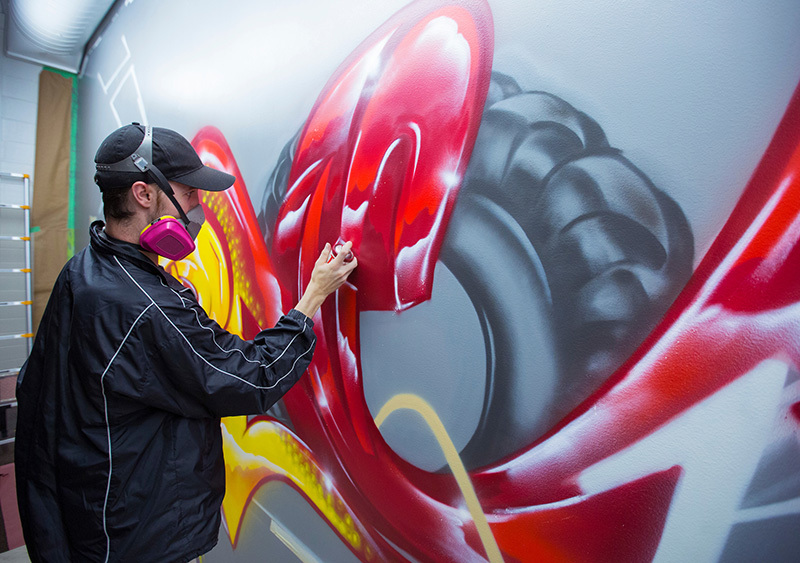
Alumnus Tim Westrom wears a respirator while he works on a mural for recreation services in a Beyer Hall fitness room. Photo by Christopher Gannon.
His earliest training, he admits, was painting graffiti on rail cars in the Cedar Rapids train yard. Back then, it was "a lot of trial and error, seeing ideas on the internet and figuring it out," said mural artist Tim Westrom, a member of the class of 2017 (BFA, integrated studio arts). By his senior year at Cedar Rapids Washington he chose to make a change, and stopped doing his art "that way." He received commissioned jobs for his school and church and didn't return to the rail yard.
Westrom's latest commissioned piece is wrapping up this week: a 35-by-15-foot wall mural in Beyer Hall for recreation services. Equipped with a respirator mask, a few ladders, several dozen cans of premium indoor/outdoor graffiti spray paint and bags of disposable tips, Westrom worked off of a black-and-white sketch as his custom mural blossomed with color and 3D-like depth.
A great fit
Recreation services' Jenny Pollard had a marketing challenge: promote a refurbished fitness room and the strength training classes (think ropes, tires, kettle bells) offered in it. This was not another yoga or Zumba classroom.
After discarding several concepts for a vinyl wall wrap, she happened upon Westrom's flier on the community billboard of a local café.
"I just thought that graffiti art would really suit the urban feel of that room. We made it sort of garage-like, to fit the muscle-building, boot camp-like nature of these fitness classes," Pollard said.
When lots of students return to classes in August, "I'm hoping it knocks their socks off," she said.
Hiring Westrom took more than a phone call and an invitation, Pollard said. On the way to developing a contract with Westrom via procurement services, she also received advice from university museums, Memorial Union employee Letitia Kenemer (who oversees all student art on campus) and environmental health and safety.
Later this summer, Westrom hopes to land in Minneapolis, where he said he most likely won't seek fulltime employment as a graffiti artist. But he won't stop creating murals.
"I hope to keep it as a lighter thing to do on the side," he said. "I still want to enjoy it, without having to depend on it for a living."
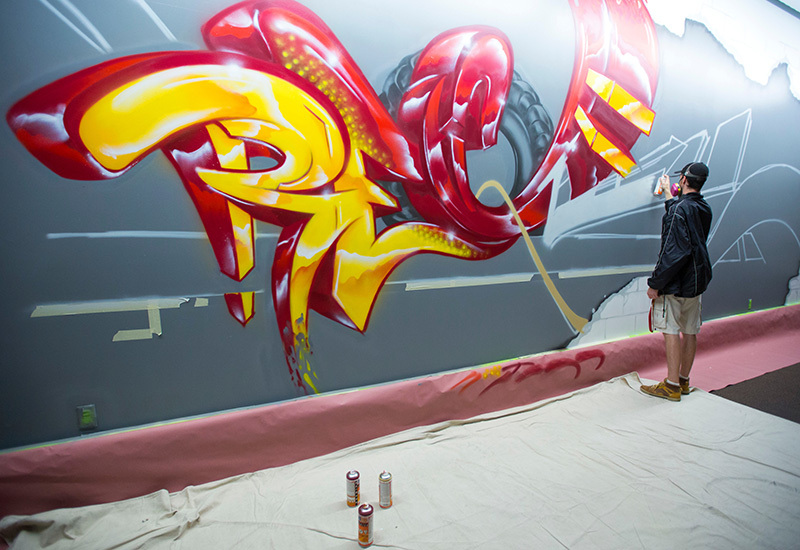
Alumnus Tim Westrom took on a 35-foot-long wall to create a custom mural in Beyer Hall for recreation services. Photo by Christopher Gannon.
Summertime brings visitors to campus
Iowa State will host several events during the summer months, drawing thousands of visitors to campus venues.
Smaller events range from dance and cheer camps, to an international linear algebra society conference (July 24-28). The largest groups, bringing more than 500 visitors to campus this summer, include:
- Special Olympics Iowa summer games, May 25-27 (4,000)
- ISU orientation for new students and their families, May 30-June 30 (5,000)
- USA Track and Field state meet, June 17-18 (1,000)
- Iowa Reading Association conference, June 27-28 (600)
- Iowa 4-H Youth Conference, June 27-29 (850)
- Iowa Games, July 8-9, 14-16 and 21-23 (3,500)
- BravO National Dance Competition, July 10-16 (1,000)
